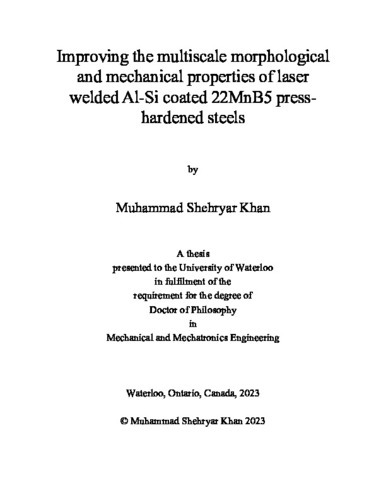| dc.contributor.author | Khan, Muhammad Shehryar | |
| dc.date.accessioned | 2023-03-27 14:32:46 (GMT) | |
| dc.date.available | 2023-03-27 14:32:46 (GMT) | |
| dc.date.issued | 2023-03-27 | |
| dc.date.submitted | 2023-03-11 | |
| dc.identifier.uri | http://hdl.handle.net/10012/19230 | |
| dc.description.abstract | In the automotive industry, the demand for reduced vehicle weight, improved safety and enhanced crashworthiness qualities continues to rise which introduces the need for parts and components with tailored properties. This demand can be met by making use of tailor-welded blanks (TWBs), which allow the production of highly optimized and complex components that are simultaneously lightweight and exceptionally strong. An example of this type of component is the B-pillar which is produced by laser-welding different types of press-hardened steels (PHSs) to offer increased elongation properties where improved energy absorption is required, while also providing an increased yield strength where preservation of structural integrity under high dynamic load is required. Parts produced using TWBs offer many different advantages like weight reduction, part consolidation, and improved part performance.
The laser welding of Al-Si coated PHSs to produce TWBs is known to cause the formation of a softer ferrite phase in the welded joint due to the mixing of the Al-Si coating in the molten weld pool. It has been shown that the formation of this phase is the principal reason for premature failure of these laser-welded joints. Industry is currently removing the Al-Si layer prior to welding using laser ablation but other techniques have been developed to weld through the coating by either using secondary or modified coatings. This thesis reviews the existing literature on the problems associated with the laser welding of Al-Si coated 22MnB5 steel and several recent solutions to this problem will be discussed. As part of this research, several novel solutions to solve the problem of weld softening have been considered. It has been observed that for certain given conditions, welding through a secondary or modified coating made of austenite stabilizing elements decreases the ferrite content and increases the strength of the weld without the need to remove the Al-Si coating prior to welding. The final chapter of this thesis discusses the effect of alloying Ni with 22MnB5 on the morphology, crystallography, and mechanical properties of the steel to offer insights into potential advancements in the development of new press-hardened steels. The thesis concludes with several recommendations for future work. | en |
| dc.language.iso | en | en |
| dc.publisher | University of Waterloo | en |
| dc.subject | fiber laser welding | en |
| dc.subject | laser welding | en |
| dc.subject | press-hardened steels | en |
| dc.subject | Al-Si coated 22MnB5 | en |
| dc.subject | tailor-welded blanks | en |
| dc.subject | coating ablation | en |
| dc.subject | coating modification | en |
| dc.subject | ferrite suppression | en |
| dc.subject | austenite stabilizing elements | en |
| dc.subject | hot-stamped steel | en |
| dc.title | Improving the multiscale morphological and mechanical properties of laser welded Al-Si coated 22MnB5 press-hardened steels | en |
| dc.type | Doctoral Thesis | en |
| dc.pending | false | |
| uws-etd.degree.department | Mechanical and Mechatronics Engineering | en |
| uws-etd.degree.discipline | Mechanical Engineering | en |
| uws-etd.degree.grantor | University of Waterloo | en |
| uws-etd.degree | Doctor of Philosophy | en |
| uws-etd.embargo.terms | 0 | en |
| uws.contributor.advisor | Zhou, Y Norman | |
| uws.contributor.advisor | Biro, Elliot | |
| uws.contributor.affiliation1 | Faculty of Engineering | en |
| uws.published.city | Waterloo | en |
| uws.published.country | Canada | en |
| uws.published.province | Ontario | en |
| uws.typeOfResource | Text | en |
| uws.peerReviewStatus | Unreviewed | en |
| uws.scholarLevel | Graduate | en |

